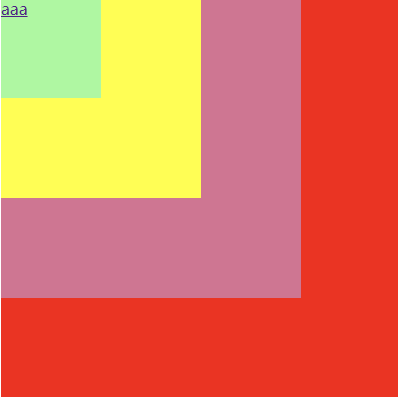1、事件冒泡
当事件发生后,这个事件就要开始传播(从里到外或者从外向里)。为什么要传播呢?因为事件源本身(可能)并没有处理事件的能力,即处理事件的函数(方法)并未绑定在该事件源上。例如我们点击一个按钮时,就会产生一个click事件,但这个按钮本身可能不能处理这个事件,事件必须从这个按钮传播出去,从而到达能够处理这个事件的代码中(例如我们给按钮的onclick属性赋一个函数的名字,就是让这个函数去处理该按钮的click事件),或者按钮的父级绑定有事件函数,当该点击事件发生在按钮上,按钮本身并无处理事件函数,则传播到父级去处理。
<!DOCTYPE html>
<html lang="en" onclick="alert('html')">
<head>
<meta charset="UTF-8">
<meta name="viewport" content="width=device-width, initial-scale=1.0">
<meta http-equiv="X-UA-Compatible" content="ie=edge">
<script src="http://cdn.static.runoob.com/libs/jquery/1.10.2/jquery.min.js"></script>
<title>Document</title>
</head>
<body onclick="alert('body')">
<!--html-->
<div style="400px; height:400px; background:red" onclick="alert(this.style.background)">
<div id="div2" style="300px; height:300px; background:palevioletred">
<div style="200px; height:200px; background:yellow" onclick="alert(this.style.background)">
<div id="div1" style="100px; height:100px; background:palegreen">
<a id="aaa" href="http://www.baidu.com">aaa</a>
</div>
</div>
</div>
</div>
<script>
//此jquery既阻止默认行为又停止冒泡
// $("#div1").on('click',function(){
// return false;
// });
window.onload = function () {
var oDiv1 = document.getElementById('div1');
var oDiv2 = document.getElementById('div2');
oDiv1.onclick = function (ev){
var oEvent = ev || event;
alert("this is div1");
//js阻止事件冒泡
//oEvent.cancelBubble = true;
//oEvent.stopPropagation();
//js阻止链接默认行为,没有停止冒泡
//oEvent.preventDefault();
//return false;
}
oDiv2.onclick = function (ev){
var oEvent = ev || event;
alert("this is div2");
oEvent.cancelBubble = true;
}
}
</script>
</body>
</html>
